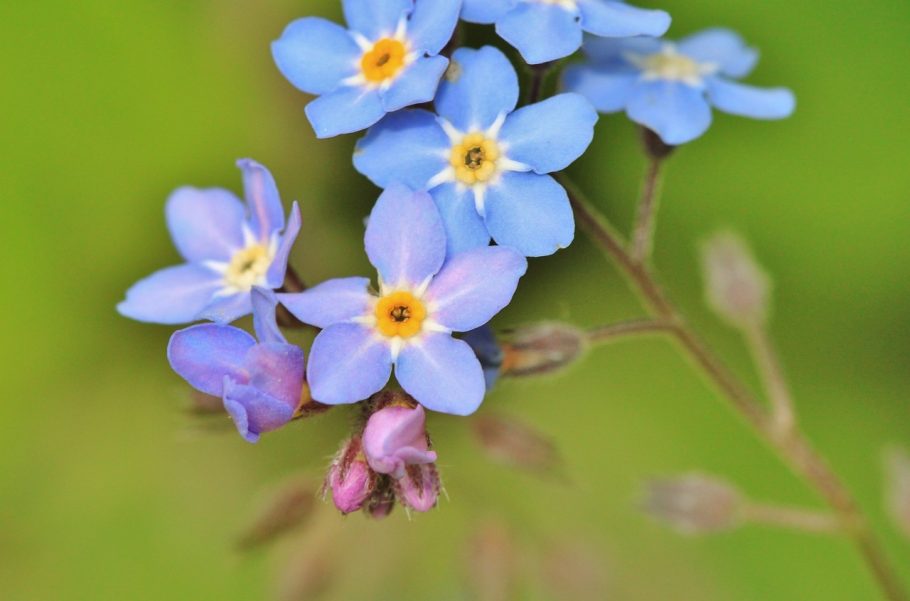Blue forget-me-nots, belonging to the genus Myosotis, are a favorite amongst gardeners for centuries. Originating from Europe, this perennial flower is known for its delicate beauty and powerful symbolism. These lovely flowers have small, five-petaled, blue blooms that grow in clusters on top of fuzzy stems. The flowers are trumpet-shaped and have yellow centers that make them attractive to bees and butterflies.
The history of blue forget-me-nots is associated with the emblematic flower known to symbolize true love, loyalty, and memories. According to legend, a knight and his lady were walking along a riverbank when he saw blue forget-me-nots. As he reached down to pick them up, his heavy armor weighed him down, causing him to sink into the river. As he threw the flowers to his lady, he called out “Forget me not!” and the flower became a symbol of true love and everlasting memories.
Blue forget-me-nots are easy to grow, making them a perfect addition to any garden. These flowers prefer cool, moist soil, partial shade, and well-draining soil. With the right care, they will bloom from late spring to early summer and re-seed themselves for years to come. Plant forget-me-nots in the fall or early spring and keep the soil moist but avoid overwatering. Deadhead regularly to encourage more blooms and cut back in the late summer to prevent them from self-seeding too much.
In conclusion, adding blue forget-me-nots to your garden will bring a sentimental and sweet touch of beauty. The history and symbolism behind these flowers make them a beautiful choice for weddings, anniversaries, and memorials. With proper care and attention, they will add a touch of elegance and charm to any garden.
Growing Blue Forget-Me-Nots
Blue forget-me-nots are a great option for gardeners who want a beautiful and easy-to-grow flower. These plants require a cool and moist environment with partial shade and well-draining soil. With the right care, blue forget-me-nots will bloom during late spring to early summer and can last for several years.
One of the unique features of blue forget-me-nots is that they effortlessly re-seed themselves. This makes them the perfect addition to any garden, as they will continue to thrive year after year. When planted in the right conditions, blue forget-me-nots will grow fast and produce a generous amount of blooms.
To get the most out of your blue forget-me-nots, it’s essential to keep the soil moist and avoid overwatering. It’s also important to deadhead the blooms regularly to encourage more flowers to grow. In the late summer, cutting the plants back can help prevent self-seeding too much.
With a little bit of care, blue forget-me-nots can be a stunning addition to any garden, providing charming blue blooms that complement other colors. These beautiful plants have been a favorite for centuries, and their popularity has only grown over time.
Planting and Maintenance Tips for Blue Forget-Me-Nots
Blue forget-me-nots are easy to grow and require minimal maintenance, making them a popular choice for gardeners. One of the most important factors to keep in mind when planting forget-me-nots is the timing. It is best to plant them in the fall or early spring, before temperatures rise too much.
When it comes to soil pH, forget-me-nots are quite tolerant. They can grow well in slightly acidic or alkaline soil. However, it is important to keep the soil moist but avoid overwatering, as this can lead to root rot.
Deadheading the flowers on a regular basis can help to encourage more blooms, which will in turn create a fuller and more vibrant display in your garden. Furthermore, cutting back the plants in late summer can prevent them from self-seeding too much and taking over your garden.
Overall, blue forget-me-nots are relatively low maintenance plants that can add a charming touch to any garden. By following these simple tips, you can help ensure that your forget-me-nots thrive and provide a beautiful display year after year.
Tips for Pruning Blue Forget-Me-Nots
One of the key things to keep in mind when pruning blue forget-me-nots is that you want to encourage bushier growth. One way to do this is to pinch back young seedlings. This helps the plants become fuller, with more leaves and blooms. Additionally, regular deadheading can help encourage more blooms and prevent the plant from self-seeding too much. When deadheading, remove spent flowers from the stem as soon as they wilt or fade. This will help the plant put more energy into producing and maintaining healthy blooms rather than into producing seeds.
Another important consideration when pruning blue forget-me-nots is timing. Deadheading and pruning should be done in the late summer or early fall, after the plant has finished blooming for the season. If you wait too long to deadhead, the next year’s blooms may be delayed or reduced in number. Overall, a little bit of pruning can go a long way when it comes to keeping your blue forget-me-nots healthy and blooming year after year.
How to Propagate Blue Forget-Me-Nots
To propagate blue forget-me-nots, there are two methods: division and self-seeding. Division is a great option if you want to produce more plants and expand your garden. To propagate by division, gently dig up the plant in the fall or early spring, separate the roots into sections, and replant them. Each section should have several leaves and a healthy root system. Make sure to plant them at the same depth as they were previously growing. Water well and wait for them to establish themselves.
On the other hand, self-seeding is an easy and low-maintenance option. Blue forget-me-nots naturally drop their seeds, and they will germinate and grow in the right conditions. To propagate by self-seeding, let the flowers go to seed and allow nature to take its course. Make sure to leave the seed heads on the plant until they have thoroughly dried out, then collect the seeds and store them in a cool, dry place until spring. In early spring, scatter the seeds in your desired location and gently press them into the soil. Water regularly and wait for them to sprout.
Regardless of the propagation method you choose, make sure to provide your blue forget-me-nots with the right growing conditions. With proper care and attention, your blue forget-me-nots will thrive and add a touch of sentimental beauty to your garden.
The Meaning and Symbolism of Blue Forget-Me-Nots
Blue forget-me-nots have a deep meaning and symbolism, making them a popular flower choice for special occasions such as weddings, anniversaries, and memorials. True love, memories, and loyalty are represented by these delicate blue flowers. The legend of the name suggests that a knight and his lady were walking along a riverbank when he saw the blue forget-me-nots. As he bent down to pick them, his armor caused him to sink into the water. Before being pulled under, he tossed the flowers to his lady and called out “Forget me not!”
In addition to their romantic symbolism, blue forget-me-nots are also a symbol of Alzheimer’s awareness. The Alzheimer’s Association uses this flower to raise awareness of the disease and to remind us to never forget those who are affected by it.
Growing and caring for blue forget-me-nots is easy, making them a great addition to any garden. With the right conditions, these flowers will bloom from late spring to early summer and continue to re-seed themselves for years to come. Regular deadheading will encourage more blooms, and pruning the plant will result in bushier growth. Propagation can be done by division or by allowing the plant to self-seed.
Overall, blue forget-me-nots are a sweet and sentimental flower that not only add beauty to your garden, but also carry deep meaning and symbolism.
Forget me not!
The legend behind the name of blue forget-me-nots is one that has been passed down through the ages. It tells the story of a knight and his lady love walking by a riverbank when he saw a beautiful blue flower. As he reached down to pick the flower, his armor weighed him down, causing him to sink into the water. As he was about to be swallowed up by the river, he threw the blue flowers to his lady love and called out, “Forget me not!”
This legend has led to blue forget-me-nots being a symbol of true love, memories and loyalty. It’s no wonder that they are still a popular flower for weddings, anniversaries and memorials. Planting this beautiful perennial flower in your garden can add a touch of sentimental beauty that will remind you of love and loyalty every time you see it. So why not plant some blue forget-me-nots in your garden and enjoy their delicate beauty for years to come?
Blue forget-me-nots have been a beloved flower for centuries, and for good reason. This delicate perennial, native to Europe, boasts a sweet simplicity that makes it a favorite amongst gardeners and flower enthusiasts. Its symbolism of true love and memories makes it a perfect addition to weddings, anniversaries, and memorials.
If you’re looking to add blue forget-me-nots to your garden, you’re in luck. These flowers are easy to grow, and with the right care, they will bloom from late spring to early summer and re-seed themselves for years to come. They prefer a cool, moist soil with partial shade and well-draining soil. To keep them thriving, make sure to deadhead them regularly to encourage growth and cut them back in the late summer to prevent excessive self-seeding.
If you’re interested in propagating your blue forget-me-nots, you can do so by division or self-seeding. Propagating by division involves gently digging up the plant in the fall, separating the roots into sections, and replanting them. To propagate by self-seeding, simply allow the flowers to go to seed and let nature take its course.
Overall, blue forget-me-nots are a perfect addition to any garden, not just for their beauty and simplicity, but for their rich symbolism as well.





